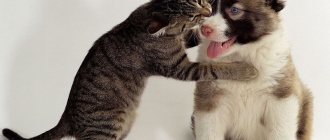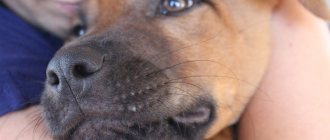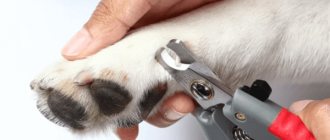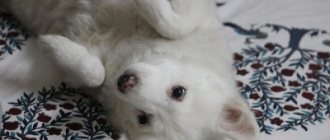Home / Articles / Health and Recreation
November 7, 2022 |
Furry pets often live in families with small children. Cats usually take care of babies and sometimes make real “nannies.” Trusting the child as an adult owner, purrs sometimes suffer from childish curiosity.
For example, a young researcher can try to find out what happens if a cat's whiskers are cut off? This is a risky undertaking - both for the experimental animal and for the baby. But the situation is quite common. Can a cat's whiskers be trimmed? Do cats grow new whiskers? Zoologists have an answer to this question.
What are vibrissae?
Contrary to popular belief, the whiskers on the faces of furry pets have nothing to do with decoration. They are endowed with exclusively applied, navigation functions. During evolution, many mammals acquired such a tool. This is especially true for animals living in conditions of limited visibility.
Vibrissae are part of the short-range orientation system
The word “vibrissae” comes from the Latin “vibro”, which means “wriggle”. This term refers to the receptors of the organs of touch.
Main characteristics:
- shape - straight or twisted;
- color - white or black;
- quantity - from 33 to 40;
- length - from 5 to 7 cm;
- location - underpads, chin, cheeks, eyelids, tail, ankles, paw pads.
In representatives of some breeds, for example, the Maine Coon, the length of the whiskers can reach 19 cm. In the Cornish Rex they are small and curled at the ends. Sphinxes are sometimes born without whiskers, which does not prevent them from orienting themselves in space.
Vibrissae structure
One of the distinctive features of tactile hairs is elasticity. This quality is achieved due to the conical narrowing of the vibrissae towards the end. They are rooted in the skin 3 times deeper than wool, which makes it possible to trigger the mechanism for transmitting information coming from outside to the brain. Each whisker has a separate “representation” in the brain, similar to the sense organs.
At the base of the vibrissa there is muscle tissue supplied with a large number of nerve endings. They are connected to a specific part of the brain. The vibration of the hair excites the root, and the impulse is instantly transmitted to the desired section.
Scientists claim that cats' whiskers give them a three-dimensional night vision. Unlike information obtained through hearing, smell or vision, whiskers contribute exclusively to short-range orientation.
Vibrissae help a cat learn about the world around it
Interesting Facts:
- vibrissae are denser than hair;
- controlled by different muscle groups;
- pick up the slightest air vibrations;
- are formed before the fur.
There is a version that hair and whiskers have different evolutionary origins. Tactile hairs appeared in the ancestors of mammals much earlier than wool.
Whiskers are sensitive to negative electrical charges that arise when stroking a cat against the grain.
Main functions
A cat's whiskers, otherwise called whiskers, are the most important organ of touch. Through the nerve endings located on them, the received information enters the brain.
They perform the following functions:
- Helps to navigate in space. Everyone knows that cats move without bumping into objects even in complete darkness. In this they are helped not only by their visual organs, but also by their whiskers, which allow them to determine the size and distance to objects. Thanks to the vibrissae, they reliably understand whether they can pass through a small opening or not.
- Food analysis. In addition to the sense of smell and mouth, vibrissae are also involved in assessing the properties of food: its freshness, taste, temperature and safety.
- For hunting. They allow you to detect the slightest movements of the victim, even if it is very far away. They also make it clear whether the potential victim is alive or not.
- For communication. The disposition to communicate can be seen by their location. If the cat is irritated and does not want to be touched, then he will press them to his face. Fluffy, twitching and sticking out always signal readiness for games and a good mood.
Main functions of the mustache
What disorders are associated with loss of mustache?
The sudden loss of a large number of mustaches is associated with the development of the following diseases:
- vitamin deficiency (lack of vitamin A, D and some microelements in the pet’s body);
- diseases of the thyroid gland (hypothyroidism, hyperthyroidism);
- diabetes;
- allergic reaction to food or certain substances;
- metabolic disease;
- skin diseases.
If a cat loses a significant number of its whiskers by the roots, it must be shown to a veterinarian. Self-medication will worsen your pet's condition.
Causes of mustache breaking and falling out
If the animal's health is not impaired, a new, smooth and shiny one will eventually grow in place of the lost antenna. The situation is much more alarming when the fur on the cat’s face begins to shed abundantly, forming bald spots and affecting the whiskers. The owner needs to carefully analyze the peculiarities of keeping, feeding and well-being of the pet, since there may be several reasons for the disappearance of a cat’s whiskers.
Vibrissae can break off and fall out:
During the molting period of a grown-up kitten, when the baby fur is replaced by an adult one. This is confined to the age of 5-6 months and is a normal physiological phenomenon: having dressed in a new fur coat, the teenager will grow a new chic mustache. As a result of a cat's curious nature, which makes it reach out to unfamiliar objects with its muzzle
Sometimes this turns out to be a dangerous adventure, such as instantly incinerating your mustache when trying to approach a lit kitchen stove burner. When handling an animal carelessly. Out of ignorance and lack of intelligence, children can harm a cat by pulling its whiskers or cutting them with scissors. During a showdown with relatives
If several cats live in the house, then fights occur between the animals, ending with scratches, bites, tearing out tufts of fur and loss of whiskers. As a result of an unbalanced diet. Feeding exclusively meat and fish or cheap economy-class dry food leads to an imbalance of minerals and hypovitaminosis. A lack of Omega-3 fatty acids and taurine also affects the condition of the coat. Being one of the symptoms of allergies. The appearance of redness, bald spots and itchy, weeping areas can be the result of food allergies, as well as increased sensitivity to other factors, such as plastic dishes and household chemicals that are used to clean the cat's dishes and litter box. Due to fungal infection (dermatomycosis). The notorious ringworm is caused by fungi from the genus Trichophyton and Microsporum, and is characterized by rapid hair loss, redness of the skin, itching and scratching. Primary lesions are usually localized on the face, head and ears, subsequently spreading throughout the body. When affected by ectoparasites. Cat fleas bite through the skin and drink the blood of the host animal, and their saliva at the site of the bite causes an irritation known as “flea dermatitis.” Thinning, loss and increased fragility of hair and whiskers can also be a consequence of lice parasitism. Many cats that go out on their own become infected with microscopic mites (ear mites and scabies), which gnaw passages in the skin, causing severe itching and disturbing the structure of the coat. As a symptom of hormonal imbalances. Disruption of the endocrine glands (thyroid, adrenal glands, ovaries) affects the general condition of the coat, the density and symmetry of hair growth, as well as pigment production and coloration. With frequent bathing. Abuse of washing with detergents that destroy the protective fat layer on the skin leads to dryness, dandruff and brittle hair. As a reaction to excessive dry air. Some owners blow-dry their long-haired cats after bathing, which is not very good for the condition of the integumentary tissue. The problem can also arise in the winter when the central heating is turned on. As a feature of the breed. Hairless cats, due to a gene mutation, tend to remain without whiskers.
The owner should take into account the sudden “hairlessness” of his pet and, if possible, try to eliminate the reasons that caused it. Questions related to feline health should be addressed by a qualified veterinarian
Does a mustache grow?
Whiskers that are lost, trimmed, or otherwise damaged will grow back in their original location. A completely lost mustache usually grows back within a few weeks. If your cat has had severe hair follicle trauma, the lost whiskers may never grow back, but this is quite rare.
Whiskers do not grow slower or faster depending on the cat's age, but at approximately the same rate throughout the cat's life.
The length of the whiskers is determined genetically, and once they reach a certain length, they will stop growing and will remain approximately the same length throughout your cat's life. The mustache does not grow indefinitely, so it does not need to be trimmed or trimmed.
Further care for the animal if its whiskers have been cut off
Do lost whiskers grow back in cats: even after trimming the hairs on the eyebrows and chin, they will be restored in 14-21 days. There are no special means to accelerate their growth - doctors advise using multivitamin complexes specifically designed for animals. They allow hairs to grow faster and become thicker.
Natural recovery will occur provided that no damage to the hair follicle occurred at the time of loss of the mustache. Animal care includes:
- protecting it from hot objects: fireplaces, gas and electric stoves, candles;
- using a special cap will help reduce the risk of head injuries;
- if a pet is placed in a cage for a while, then it will not be able to accidentally harm itself;
- an injured animal should not be allowed out into the street - there it can get under the wheels of a car, fall from a height, crash and damage not only its paws, but also its head.
Each new haircut of the whiskers will cause aggression in the pet towards its tormentor. If there are children in the house, then they immediately need to be explained why there are hard hairs on the cat’s body and what the risk of losing them is.
Trimming whiskers will not make a cat look beautiful; they play a big role in choosing a partner and communicating with familiar and unfamiliar relatives. Having lost their sixth sense organ, animals cannot hunt or move through previously unexplored places. Nature has protected furry pets, but it will take a long time to recover from the loss, during which time they can suffer seriously. Any stressful situation does not pass without a trace, then you should not be surprised at an animal that is aggressively opposed to its own owners.
Source
What happens if you cut a cat's whiskers?
If you trim a cat's whiskers and eyebrows with scissors or clip them, the pet will experience severe stress and may become disoriented in space: huddle in the far corner of the room, lose appetite and interest in outdoor games. Therefore, you cannot trim or shave your mustache for the sake of hygiene or aesthetics. And if the animal is still left without whiskers, for example, after a fight for territory or playing with children, watch it extremely carefully.
There will be no changes in coordination and gait. The animal will retain its natural agility in daylight, but will feel unsteady at night.
Is it possible to trim a cat's whiskers?
Like other hairs, they gradually die and fall out, and new ones grow in their place. This process occurs throughout life and does not stop even in old age. Over time, they thicken, darken and gradually begin to turn gray. A fallen tendril is often only half colored. In addition, its end is generally very sharp. In older pets, the rate of replacement after loss slows down significantly.
Trimming a cat's whiskers is strictly prohibited! If you do this, they will grow back very slowly. In addition, the entire period of their regrowth will be quite difficult for animals to tolerate.
Vibrissae
Scientists have even conducted research by cutting off whiskers and observing changes in behavior. Some representatives continued to behave as usual, but most were scared and confused. At the same time, all experimental subjects had the following problems:
- Poor orientation in dark places and bumping into things around them.
- Getting stuck in narrow passages more often due to the inability to objectively assess their dimensions.
- Reduced jumping accuracy. They did not reach or landed on the side of the objects they planned to jump on.
- For cats that are only at home, this is not so scary. But for pets going outside, this is fraught with unpleasant consequences. The inability to accurately navigate in space can even pose a threat to their lives.
We doubt that adults will come up with the idea of cutting off a pet’s sense organs. But children are many times more curious and enterprising.
That is why it makes sense to explain to them from an early age that under no circumstances should you cut a cat’s hair.
After all, because of this, she will become quite clumsy, timid, nervous, and perhaps even stop communicating with her household.
Why do mustaches break?
How to spend less gasoline by planning your route correctly?
Often, from year to year, motorists persistently follow the established habit and drive from home to work or to other objects strictly along the same route, not realizing that they can choose a different route that will be less congested with vehicles, on which there will be fewer traffic lights and , after all, which will be shorter in distance. Choosing the optimal route among the possible ones will save gasoline. A navigator or a special program installed on your phone (2GIS, Google Maps or some other) will help you solve the problem of choosing the optimal route. You can also find out which road there is a traffic jam on at the moment, so as not to burn fuel in vain trying to drive along it, from other drivers, for example, by using a car radio.
Why hairs fall out
If it’s not just another change of hard hairs, then why does a cat’s whiskers fall out? This is a question that inexperienced owners often ask online.
Loss of whiskers occurs due to disorders in the animal’s body, so it is important to recognize the symptoms in time and take action. We suggest you read: How to teach a cat commands: give a paw, bring a toy, walk on its hind legs || We teach a cat to follow 8 commands, little secrets and tricks. We suggest you read: How to teach a cat commands: give a paw, bring a toy, walk on its hind legs || We teach a cat to follow 8 commands - little secrets and tricks
We suggest you read: How to teach a cat commands: give a paw, bring a toy, walk on its hind legs || We teach a cat to follow 8 commands - little secrets and tricks
Hypothyroidism usually occurs in older cats. This disease affects all body systems and leads to increased metabolism. In addition to the loss of the mustache, other signs are observed:
- wool properties deteriorate;
- the animal is hyperactive and noticeably nervous;
- appetite increases with weight loss;
- the pet experiences increased thirst, which it constantly strives to satisfy;
- sometimes diarrhea and vomiting occur.
The roots of the whiskers, compared to the roots of the fur, are located quite deep in the skin. They are surrounded on all sides by nerves, blood vessels and sensitive muscles. The development of a bacterial skin infection or the proliferation of parasites in the facial part of the head often explains why a cat's whiskers fall out. Such pathologies, accompanied by unbearable itching, are easily identified during an initial examination of the skin.
These disturbances in the hormonal system lead to changes in metabolism. Diabetes mellitus in middle-aged and elderly cats is usually indicated by such signs as increased thirst and frequent urination, excessive appetite against the background of general exhaustion of the body. The pet needs immediate help, otherwise the patient’s condition will worsen, and the loss of the antennae, compared to other problems, will no longer be noticeable.
The cat's body, like the human body, can react completely unexpectedly to some foods. Loss of whiskers and fur, accompanied by itching, redness of the mucous membranes, profuse salivation and discharge from the eyes - a condition caused by an allergic reaction.
Non-food allergies can be triggered by a variety of chemicals, certain types of plants and other objects that appear in a cat's environment. It is sometimes very difficult to determine what exactly caused the rebellion in the body; you have to use the method of elimination. The course of treatment will require the use of antihistamines.
In any case, you don’t need to think long about why your cat’s whiskers are falling out - a veterinary clinic specialist will explain in detail what to do in this situation.
What happens if you cut off an animal's mustache and eyebrows?
The role of whiskers in the life of cats is great, so if they are trimmed, they will at least experience discomfort. According to research, animals without whiskers have poorer spatial orientation because their brains lack information about the world around them. Cats begin to bump into objects and get stuck in narrow holes. During jumps, they often fall, not reaching the desired object or missing. Street animals especially suffer from the loss of whiskers - they cannot fully hunt, experience problems with food, and are often injured.
Different cats react differently to damage to the whiskers: the behavior of some is not particularly different from usual, others feel extremely insecure without them, become more withdrawn and nervous, move less, and their mental state worsens. A cat without a whisker loses coordination, so you should be careful and not let a whiskered animal out of the house to avoid injury.
How does the loss of a whisker affect the health and behavior of a pet?
The most common are a sharp loss of the ability to move normally, navigate in the dark and in space, adequately assess the size of objects, the distances to them and between them. The accuracy of jumps and adaptability to new environments also decrease. The cat’s overall activity decreases, he becomes less playful, withdrawn, and sometimes even aggressively fearful. You need to give your pet time to get used to the new circumstances and wait until the mustache grows back. If the whiskers do not recover after a month, then it is better to seek help from a veterinarian.
Vibrissae structure
The roots of the mustache are located deep in the tissues. They are equipped with nerve endings. The information received is sent to the brain and changes the animal’s behavior.
The largest part is located on the muzzle in four rows. On average there are 24 of them. The length of each reaches approximately 6-7 cm. For individual breeds, the value can vary significantly up or down.
The Guinness Book of Records has recorded the longest 19-centimeter mustache on a representative of the Maine Coon breed.
Outbred cats turn out to be better hunters the longer their whiskers are. It has been noticed that skinny cats have thinner hair than well-fed ones.
In addition to the cheeks, vibrissae are located on the chin, above the eyes, on the tail and paws. They are much shorter, but have the same purpose.
Reasons why mustaches break and fall out
The structure of the mustache is based on keratin, one of the components of the fur and claws. Domestic cats' whiskers can fall out just like their fur. This process is natural and should not cause the owner to panic.
| Causes of brittle and thin vibrissae | Rationale |
| Avitaminosis | A lack of vitamin A can lead to mustache fragility and loss. Ascorbic acid deficiency leads to disruption of collagen synthesis, which causes massive loss of cat antennae. As a rule, vitamin deficiency also affects the condition of the coat; |
| Allergy | Allergic manifestations most often concern the fur, but may also be accompanied by loss of the pet’s whiskers; |
| Endocrine system diseases | Diabetes mellitus and pathologies of the thyroid gland are often accompanied by hair loss and loss of whiskers; |
| Skin diseases | Serious dermatological diseases, such as ringworm, parasitic and fungal infections, are accompanied by itching and loss of not only hair, but also whiskers; |
| Low collagen content in food | The factors influencing the fragility and loss of whiskers are in many ways similar to the reasons why whiskers do not grow. The fragility of the sensory apparatus is caused not only by the absence or deficiency of vitamins and minerals, but also by the lack of collagen in food. |
Owners of Sphynx cats should not worry about short whiskers on their pets. The peculiarity of these animals is that the whiskers are short, sometimes with curls.
If there is a child in the house, then the pet often becomes a victim of children's experiments. Will a cat's trimmed whiskers grow back? This is a question often asked to veterinary specialists by parents of naughty children. After about 2 - 3 months, the cut off vibrasses are restored in a healthy animal. If you clearly explain to your child that the cat will be sick and sad without its whiskers, this problem can be avoided in the future.
Often, owners may notice that their pet is not growing new whiskers. This phenomenon occurs if the hair follicles are damaged for any reason. A cat may, for example, accidentally singe its whiskers. Follicles are damaged by fungal and parasitic diseases, severe dermatological pathologies. Only a veterinarian can help solve the problem in this case.
Animals react differently to the lack of the sensory apparatus they need. Most pets experience a depressed state and normal orientation in space is disrupted. There is often a lack of coordination when moving. Understanding what will happen if a cat's whiskers are cut, the owner will not do this on purpose and will explain to the children the consequences of such manipulation.
Consequences of loss
The consequences of trimming cats' whiskers can be very varied and depend on whether the animal is a pet or an outdoor one, as well as on individual characteristics. The most difficult situation for the lack of their sensory sensors is street cats who are forced to get their food in the wild. Without whiskers, it will be difficult for backyard predators to track their prey and hunt successfully.
What happens if a cat's whiskers are trimmed depends on the individual sensitivity of a particular pet. At first, some animals may lose the ability to navigate normally in the surrounding space.
There are cases where cats deprived of whiskers could not walk in a straight line for a certain time, fell and lost orientation in space. This failure in the animal’s navigation system is due to a sharp lack of signals about the environment entering the brain.
Of course, such extreme manifestations are not typical for all animals. Most often, the loss of whiskers leads to the fact that it is more difficult for a pet to make accurate jumps and navigate in the dark. Without whiskers, a cat more often stumbles upon obstacles and does not navigate in an unfamiliar environment.
Veterinary experts under no circumstances advise owners to trim or trim their animal's whiskers. Such manipulation can lead to stress, fearfulness, and inappropriate behavior. Some especially sensitive pets have a hard time coping with the loss of their whiskers: they become withdrawn and become non-communicative. Cats sleep for a long time and stop leading an active lifestyle.
To see what happens if you cut a cat's whiskers, watch this video:
A child trimmed his cat's mustache: what should I do?
The worst thing is if a child cuts off the cat's whiskers completely. It is unlikely that he allowed such blasphemy to be committed on himself, but the baby could have managed to do it in his sleep. Most often, the animal reacts to the slightest encroachment on its whiskers - the child only manages to shorten a couple of hairs. If an emergency occurs, a logical question arises: “The cat’s whiskers were cut, what should I do?”
Don't panic too much. The main thing is that the child himself does not suffer from the revenge of his furry friend. After all, encroachment on the vibrissae can provoke aggression in the animal.
The mother or father should have an explanatory conversation with the child and scold him so that he no longer has questions about whether it is possible to trim the cat’s whiskers.
What and why
It’s not for nothing that even in fairy tales it was emphasized: mustachioed and striped. Gorgeous long whiskers are a source of pride for a cat, and often for its owners. Yes, nature gave them for a reason. Let's first look at why a cat needs a mustache. In addition to their decorative function, they are also an organ of smell. They even have a second name, which is rarely mentioned in everyday life.
Why does a cat need a mustache and can it be cut: interesting facts
Many who have pets wonder why a cat needs a mustache and whether it can be cut. Veterinarians prohibit this, explaining that the animal is deprived of the important organ of smell and touch for a long period of time. Vibrissae (vibrate, tremble) help to navigate the terrain and quickly assess your capabilities as a hunter. Thanks to its whiskers, even a blind cat accurately finds its way home and is never left without food.
What happens if you trim your cat's whiskers?
Will it hurt a cat if its whiskers are trimmed? Not really. As mentioned, the whiskers are similar to other hairs on a cat's body. The only difference is that they are thicker and perform a different function.
There are no nerves around the cat's whiskers, so there is no risk of bleeding or pain. However, if you trim a cat's whiskers, the cat finds itself in a situation where it loses the ability to correctly navigate in space.
This means that by cutting off a cat's whiskers, you are depriving the animal of the ability to perceive anything due to its poor eyesight. If you trim your cat's whiskers, your pet will not be able to distinguish between objects that are close or far away. In addition, the opportunity to find out whether the movement in space is proceeding correctly will be lost, so the cat will become somewhat clumsy.
And due to the lack of natural abilities, the cat whose whiskers have been trimmed becomes nervous from tension. Therefore, taking into account all the above information, under no circumstances is it recommended to trim the whiskers of cats.
Meaning of mustache
At the base of the cat's whiskers are muscles containing nerve endings. Each of them is connected in a certain way to the brain. At the slightest vibrations of the whiskers (vibrissae), the necessary information is transmitted at the impulse level. Scientists have found that through these hairs, representatives of the cat family have a three-dimensional specific vision of the world around them in the dark.
Table No. 1. The importance of mustaches and eyebrows for cats
Vibrissae are a way of transmitting an emotional background. If the hairs are pressed closely to the base of the muzzle, then she does not want to make any contact. Antennae that stick out in all directions signal that the animal is ready to play and frolic.
Thanks to their high tactile properties, whiskers and eyebrows help the cat to correctly identify the location of the enemy and instantly build strategic, error-free actions.
There is a significant disadvantage among felines. The lower half of the muzzle belongs to the blind spot; they absolutely cannot see objects that are located below. The mustache made it possible to compensate for this omission of nature
With the help of its whiskers, a cat, even a blind one, can navigate the surrounding space and receive maximum information about the objects around it. She feels the thickening of the air next to the object and even with limited visibility she senses it on an instinctive level
The necessity of cat whiskers and what they are scientifically called
Why do cats need whiskers? Whiskers are a sensitive organ of touch for cats.
With the help of its whiskers, the animal navigates space, studies surrounding objects and finds prey.
This organ acts as a collector of information that it transmits to the brain.
Areas of the body where the mustache is located:
- On both sides of the nose.
- Above the eyes.
- On the sides of the head.
- On the ankles of the front paws.
- On the tail.
In total, the animal has from 30 to 35 whiskers with an average length of 5-6 cm. The largest number of them is located on the head.
With the help of whiskers, a cat controls the prey when it holds it in its teeth
The scientific name for animal whiskers is vibrissae. The word comes from the Latin vibrissae, which means to oscillate, to wriggle.
What is a mustache?
Although we usually call these hairs "whiskers", they are scientifically known as tactile hairs or vibrissae. The name "vibrissae" comes from the Latin word "vibrio", which means "to vibrate".
Not everyone is aware of the exact role of mustaches, but of course, these special types of hair do not have a purely decorative role.
Besides cats, many animals also possess some type of whiskers, but the most common are facial whiskers. In fact, with the exception of humans and apes, all mammals have them.
While whiskers are certainly common among mammals, other land and aquatic creatures have them in some form - fish, turtles, sharks, etc.
Features of the structure of whiskers in cats and cats
There are no differences in the structure of the vibrissae in cats and male cats. This organ is not related to the gender of the animal and performs the same functions. The difference may be slight in length and thickness. But this is determined solely by genetics.
Locations
There is a common belief that cats have whiskers only on their faces. Long, thick hairs have been seen and known by everyone here. They are located:
- around the nose;
- on the lip pads;
- above the eyes;
- on the lower jaw, more precisely, on the chin.
But there are the same ones on the front legs. True, they are not so noticeable. But just look closely at the paw just above the place where the dewclaw is located, and you can easily spot them.
Vibrissae are located not only on the face, but also on the cat’s paws
Length
The length of the whiskers on a cat's face is on average 5–7 cm. But in this matter, much depends on the breed. So, the owners of the longest mustaches are Maine Coons. Their whiskers add incredible charm to their already charismatic appearance. In sphinxes, on the contrary, the vibrissae are very short, and often also curled. The owners of curly mustaches are cats that carry the Rex gene. The name of these breeds contains the prefix “Rex”. For example: Cornish Rex, Devon Rex and others.
The length of the whiskers is also determined by the cat’s nutrition. If it is balanced, the mustache will be truly luxurious.
There is a popular belief that the longer a cat's whiskers, the more mice he catches. So our ancestors considered this relationship.
Thickness
The thickness of the whiskers varies only by gender: cats have thicker whiskers than cats. You can also identify differences by location:
- the mustache on the cheeks is much thicker than above the eyes;
- on the front legs the vibrissae are only slightly ahead in thickness of the animal's guard hairs.
In general, the thickness of the vibrissae is explained by the fact that the place where each hair grows is rich in nerve endings. And if you consider that their number is quite large, then it becomes clear why the vibrissae has a tubercle at the base.
Other structural features
The vibrissae themselves are already a very mysterious organ. Each hair has a connection with its own part of the brain and is responsible only for a specific function. Therefore, if a cat loses one of its antennae, it temporarily experiences problems in hunting, coordination, touch, etc.
Each antennae is equipped with nerve endings and has its own “representation” in the brain
Why do cats' whiskers turn black or white?
The color of the whiskers directly depends on the color of the animal itself. They can be white, black, red or several colors at the same time. Usually a black cat has black whiskers, but sometimes white whiskers are normal. In some breeds they turn black over time.
If a cat with a white mustache has acquired a black color, this phenomenon also does not mean anything terrible, just a normal change in hair pigmentation. You should be wary if the color, on the contrary, changes to white. Sometimes this can be a symptom of a disease. Therefore, even with a slight deviation, it is worth consulting with a veterinarian.
It's hard to imagine a cat without a luxurious mustache! However, nature did not invent them for beauty. Century after century, whiskers have helped cats survive in the wild, and today house hunters cannot do without them either. So what is their function? About this in our article.
What is the correct name for a cat's whiskers and what are they?
Cats' whiskers grow not only under the nose, but also on the forehead, near the eyes, on the chin and even on the paws. More precisely, it is correct to call them not “whiskers”, but “vibrissae”. These are sensitive, hard hairs, longer than the coat. In total, there are about 40 such hairs on a cat’s body, and only 24 of them are on the face.
Unlike simple hair, vibrissae are surrounded by hundreds of nerve endings and muscle fibers, and their root goes deep into the tissue.
Each whisker is a separate organ of touch, which continuously transmits a signal to the animal’s brain 24 hours a day. Vibrissae are present not only in cats, but also in many other mammals, including dogs.
Why does a cat need a mustache?
Vibrissae pick up the slightest vibrations in the air and help cats navigate in space. With such “devices”, even at night in an unfamiliar room, the cat will not crash into objects, will always smell the mouse and accurately calculate the jump distance.
Vibrissae help the cat understand whether food is safe. In the wild, the hunter seems to wrap her whiskers around a caught mouse, determining whether the prey is dead and whether it is possible to start eating. In a similar way, your pet analyzes food and treats at home
Caution in such matters is never superfluous!
Vibrissae serve for cats to communicate with each other and with humans. An attentive owner will always determine the mood of the pet by the position of the whiskers.
Is it possible to trim a cat's whiskers?
Is it possible to shorten cats' whiskers? Any specialist will answer: under no circumstances. The vibrissae are an important organ, the loss of which will result in extreme stress for the cat. A cat that suddenly loses its whiskers will become less aware of space and will feel defenseless and vulnerable until new ones grow.
Adults must explain to children that pulling out a cat's whiskers is prohibited. In addition to loss of function, it is also very painful, since the whiskers, unlike wool, are rooted deep into the tissue. Cat whiskers must remain untouchable!
What to do if your cat's whiskers fall out?
Now we know how important whiskers are for a cat. But what if they suddenly started falling out? Should we sound the alarm?
From time to time, the vibrissae are renewed in the same way as animal fur and human hair. Therefore, if you notice a fallen or broken mustache at home, there is no need to worry. This is fine!
It’s another matter if the vibrissae fall out and break in large numbers. This is a signal that something is wrong with the body. Perhaps it is a matter of seasonal adjustment, or perhaps an internal illness. Don't ignore the problem and contact your veterinarian.
Is it possible to remove cats' whiskers?
It often happens that cat owners, out of ignorance or “for the sake of beauty,” remove their pet’s whiskers. Sometimes a small child performs this action for fun, playing with the “kitty” and deciding to trim its mustache.
Doing this without a veterinarian’s prescription is strictly prohibited (the previous paragraph describes in detail what happens to a cat that has lost tactile hairs). Sometimes, due to any injuries or wounds, a cat's whiskers are deliberately removed at a veterinary clinic . But they do this only if the vibrissae are located directly on the affected area. In other situations, veterinarians never trim a cat’s whiskers and do not recommend that its owners do so.
How to help a pet who has lost its whiskers
There are no specially designed drugs or products to accelerate the growth of whiskers in cats. With a healthy hair follicle, the vibrissae grow on their own. There is no need for additional care. Veterinarians emphasize that there is no need to use any ointments or creams, this will not bring any benefit.
If it happens that your mustache breaks or falls off, you need to diversify your diet. It is advisable to include the following products in your daily menu:
Already in the 3rd week, the hairs grow a couple of millimeters, which allows the four-legged pet to again adequately respond to the world around it. Over the next 4-10 weeks, the vibrissae acquire the required size, and their receptors are completely restored.
Differences from animal hairs
There are physiological characteristics. The vibrissae are planted very deep into the skin; these are not ordinary hairs at all. Each whisker is an antenna that is surrounded by nerve cells. This is necessary to transmit signals directly to the brain center. But that is not all. Vibrissae are equipped with muscle fibers. That is, it is not hair at all, but rather complex receptors. In fact, they are responsible for the sense of smell, they just changed during evolution. The longest and most sensitive mustaches are located on top, shorter ones can be seen in the chin area. Remember that cats hunt at night, they need to quickly and silently find and catch a rodent. It is thanks to the whiskers that a cat can feel an object without contacting it and avoid colliding with an obstacle. What happens if you cut a cat's whiskers? He will lose a huge flow of information. Of course, this is not fatal at home, but it affects the well-being of the pet.
Interesting facts about mustaches
- The system of pressure on the antennae can create a feeling of anxiety in them, so use a wide plate or flat feeder to eat.
- In addition to a dozen hairs that are located on different sides of the nose, there are rather short analogues that are located near the eyes, near the chin, and on the other side of the paws in front.
- The size of the hairs is such that they are literally similar to the width of the body, so they can figure out the width of the holes for themselves without even trying to pass through it.
- The placement of the mustache can be balanced by different moods. If they are completely relaxed and straightened in different directions, then the cat feels calm. If they are turned forward, it means there is anxiety.
- Without whiskers, cats may become disoriented and experience headaches, thereby not receiving vital signals.
Why you can't trim your mustache and eyebrows
Trimming a cat's whiskers and eyebrows is strictly contraindicated. This makes their existence very difficult. Vibrissae are one of the main organs of the cat family and serve as tactile and olfactory receptors. In some animals, the hairs may fall off on their own for a variety of reasons, but then they grow back. However, specially cut hairs cause significant discomfort to the pet.
Cats should not have their hair cut because it will negatively affect their health. The pet will not lose its sense of touch or smell, but spatial orientation will deteriorate significantly. Instead of lost or cut whiskers, new ones will grow in the cat only after 3 months. This is a very long period of time, so cats should not have their whiskers trimmed.
Damaged whiskers deprive the cat of adequate perception of the surrounding world
What problems will a cat have to face if its whiskers are trimmed?
- there is a decrease in jumping ability as a result of a deterioration in the computational function, the pet jumps or does not jump to the desired goal;
- there is a loss of the ability to accurately measure objects or distances, the cat may suddenly get stuck or fall;
- changes in behavior are observed, the animal becomes inactive, timid, and sometimes aggressive;
- the risks of injury increase, for example, a cat may lose an eye or injure its skin without noticing the threat in time due to the lack of whiskers;
- a certain disorientation develops, due to which the animal is often injured at night, gets hit by cars, and is unable to escape from the dog in time.
In most cases, while the cat's cut hairs grow back, she leads a recumbent lifestyle and loses her appetite. As a result, the fur becomes faded and loses its color. The pet stops catching mice, does not react to birds and live fish, and begins to go to the toilet in the wrong places.
Why does a cat's whiskers break?
Some cat breeds may have whiskers that break for no reason. Most often this is typical for sphinxes. If whisker breaking is accompanied by any deviations in the behavior or condition of the animal, then you should think about its health. A cat's whiskers break for the following reasons:
- Lack of vitamins. Associated symptoms are hair loss, unhealthy claws (brittleness, separation), bad breath.
- Low quality food. These could be foods that are contraindicated for cats, cheap food, or excessive amounts of fish.
- Fungal development. In this case, the structure of the mustache becomes fragile.
- The appearance of parasites in the body and lice in the coat.
If a cat rarely eats meat, his body suffers from a lack of taurine and collagen. This also causes the mustache to fall out. A vitamin-mineral complex will help correct the situation.
The owner of a furry pet may worry that the kitten's whiskers break and fall out. If the baby is still under the supervision of a cat, she can deliberately gnaw his antennae. After this procedure, he becomes calmer and practically does not leave his mother and the place she has chosen.
The process of losing whiskers in a cat is a normal phenomenon for an animal in adolescence. However, it can cause discomfort to the animal. The owner’s task in this case is to alleviate the cat’s condition at the time when his whiskers fall out. He also needs to monitor for signs that may indicate a possible disease.
Symptoms of acne in cats on the chin
Many cats first develop a slightly dirty chin, covered in small black spots between the hair follicles. Sometimes, symptoms in cats are limited to just this manifestation. In other cases, it may begin to progress into swollen, red lumps that begin to rupture and bleed.
If the problem continues to progress, it is likely that the follicles may become infected with Staphylococcus aureus. This is a fairly common bacterial infection that can usually be found on the surface of the skin. This complication is called bacterial folliculitis. This serious skin infection requires more aggressive treatment. Folliculitis can also lead to secondary fungal infections if not treated properly.
If your mustache falls out
Loss of whiskers may indicate the presence of the following problems:
1. Skin diseases. In this case, by the loss of whiskers, one can judge whether the animal has diseases such as ringworm or atopic dermatitis. 2. Fungal diseases. In this case, the affected area of the cat's skin becomes itchy and itchy. 3. The presence of parasites in the body. The coat deteriorates due to metabolic disorders, helminthic infestations, and also when infected with fleas or ticks. 4. Endocrine diseases such as hypothyroidism. If they occur, the hair becomes matted and falls out. 5. Folliculitis is inflammation of the follicles. It is caused by bacteria, fungi, and viruses.
Functions of vibrissae
The purpose of the mustache is to be a kind of radar, an organ of touch. The longest, hardest and most sensitive ones are located above the upper lip, shorter and less sensitive ones are on the chin, under the eyes, all over the body, on the ankles, pads of the paws and even on the tail.
An adult cat has 12 hairs on each side of its cheeks. The average hair length is 6 centimeters. It is noteworthy that the cat's longest whiskers come from Finland. For this feature, it is even included in the Guinness Book of Records. The length of its whiskers is 19 cm.
The vibrissae give the cat the opportunity to explore the world around them and at the same time protect it from danger and are responsible for maintaining balance. It is thanks to their whiskers that cats are excellent hunters and can navigate in the dark without any problems. With their help, animals examine food for taste and freshness.
In addition, they are an indicator of mood - an angry cat tries to press the whiskers as close to the muzzle as possible, while in a good-natured animal the whiskers are directed forward. It is not surprising that many pet owners are concerned about this question: what will happen if a cat’s whiskers are cut off?











